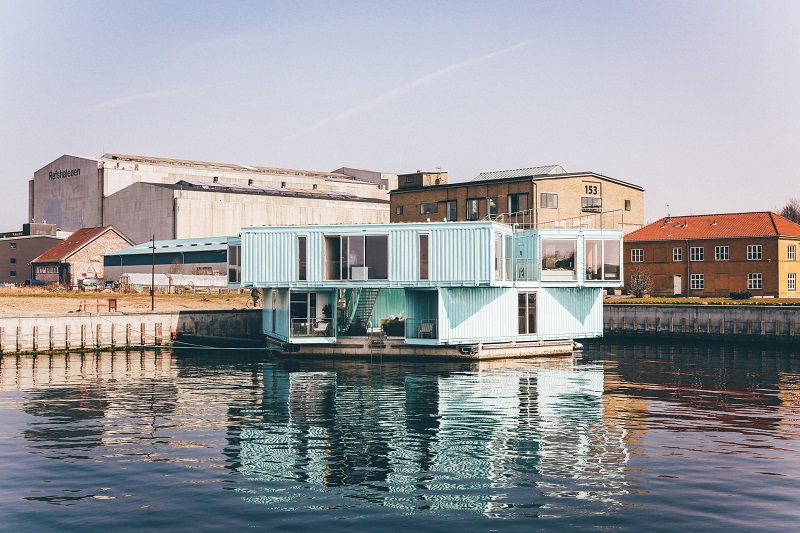A shipping container house may be an excellent option for individuals who want an eco-friendly and long-lasting living space. They also provide several advantages that other homes do not. In this blog article, you’ll discover how to build a shipping container home, as well as the benefits, materials, and tools needed to build one.
Let’s get into it!
Benefits of Building a Shipping Container Home
A shipping container home has several advantages over other homes.
For example, they are extremely durable, low maintenance, are fire-resistant and watertight when prepared properly. Additionally, shipping container homes are relatively inexpensive. The average cost of a shipping container home is $34,000 to $50,000. Larger container homes range from $100,000 to $175,000. In comparison, a traditional house costs around twice as much in some cases!
Some other benefits of building a shipping container home include:
Economic – Shipping containers are a cheaper alternative to more traditional building methods. This makes it easier for individuals with minimal funds to get their own container home built before they can’t afford land anymore!
Customizability – Shipping container homes are easy to transform. You can add windows, paint it however you’d like and make other changes depending on how creative you get.
Easily relocate – If you have to move for any reason, consider how much easier it’s going to be if your shipping container home is mobile!
How to Find the Right Shipping Container Home Design for You
You’ll want to make sure you find a home design and plans that meet your needs.
First, it’s essential to remember that shipping container homes are not a good solution for everyone. If you’re looking for a large home with a long list of amenities, it’s probably not going to be the best choice for you. However, if you’re looking for something simple and inexpensive so that you can build your own home quickly, then this is certainly an option worth considering!
If you’re seeking a more industrial appearance, two shipping containers connected might be the perfect fit! Because they are so accessible in cities like New York City, this design is already quite popular. On the other hand, consider using one long container and adding windows all around if you want something with a more modern feel.
Required Materials and Tools for Building a Shipping Container House
Although some other materials and tools may be required or desired, these are the basics that you’ll need to get started.
- Two or more shipping containers
- Flooring & insulation material
- Paint or other materials for the finish of the home
- Windows – if desired, these can be added at any time throughout construction!
- Tools – standard woodworking tools are necessary for building a shipping container home, including drills and so on.
Where to Get Your Shipping Containers
There are many places to find shipping containers for sale. But, first, consider checking with your local municipality or planning department before purchasing anything.
You can also check online for shipping container companies, although prices may vary depending upon location.
Make Sure You See the Containers You’re Buying
One of the most common mistakes people make when buying shipping containers is that they don’t see them first.
The Process of Building a Shipping Container Home
Now that you’ve got everything in order, it’s time to get started!
1. Permits and planning
Before ordering a shipping container, ensure you have all the required building code permits and planning permission from your local authorities. Confirm that you’re permitted to build a home and that a shipping container house meets local and state regulations.
To ensure that your shipping container house’s floor plan is structurally sound, work with an architect and a structural engineer.
2. Purchase a container
After that, you’ll need a shipping container. The size, type, and condition of the shipping container you choose will be determined by the scope of your project. The most common size for houses is a 40-foot, high-cube container.
In addition, consider the following factors: cost, shipping alternatives, vendor reputation, condition of the shipping container, warranties, and past buyer comments.
3. Prepare your lot
You’ve decided to purchase a shipping container, so now comes the process of determining where you’ll build your home and then preparing the ground. This entails considering the soil itself and the sort of foundation you’ll want to utilize for your house to keep it above ground level.
3. Placement of the containers
Using a crane and a delivery truck, the simplest ways to put shipping containers on the foundation are easy and inexpensive.
4. Cut out your openings
There are various ways to cut through shipping container steel, including a plasma cutter, cutting torch, grinder, and even a jigsaw (for small holes). A plasma cutter or cutting torch is the ideal tool for removing an entire wall.
5. Add doors, windows, and framing
Now it’s time to install doors, windows, and flooring. Again, you may go as simple or luxurious as you like!
6. Install a plumbing system
Consider installing a plumbing system that runs on either an electric pump or solar power.
7. Insulation for temperature control
To help control the interior temperature of your shipping container house, you’ll need insulation. The type of insulation you use will depend on where you live or what you prefer.
8. Review and signing-off on your new shipping container home
Finally! You’ve put in so much effort, and it’s all about to pay off. Have your engineer and other structural experts inspect it one last time before calling the inspector.
Learning How to Build a Shipping Container Home
Now that you’ve gotten an idea of how to build a shipping container home, we hope you feel confident on your journey to a new home!





